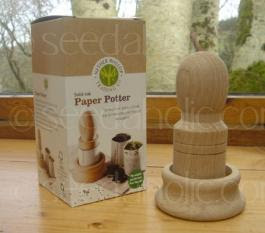a life-transforming tool
Here it is, the little tool that's making it all possible for me this sowing season. I've seen these around for years on various eco-concious websites but I never looked at them as a serious solution for my needs. I don't personally know anyone who makes their own paper pots and I've certainly never heard them recommended. Perhaps I'll look up Monty Don in a moment and find he has them on some list or other of gardening essentials, but not now or I'll never get this finished. So why did I buy? To be honest, I was enjoying shopping on seedaholic's website so much that I actually wanted to buy more from them than the seeds I had in my barrow. I presume this is what happens to those people who enjoy 'shopping' as a leisure activity? How dangerous! Anyway, it seemed the time was ripe and I invested my £9.95. I now wish I had bought the set of two which included a larger version more suited to larger seeds.
The key to the success of the little gadget is in the abundance it provides. Assuming you have paper, you can have as many little pots as your heart desires or your propogation requires. At the point of taking the above photo, I had run out of yoghurt tubs and was wondering what to prick out into. Then the paper potter arrived and the tomatoes (far left) were rehomed in a jiffy. Then I sowed my Cynara cardunculus “Cardoon” straight into pots to see how that would work out too. I made enough pots -about 40 in the time it took for my son to have his cereal and clean his teeth.
I didn't find the suggested paper dimensions worked for me and anyway I didn't have a great deal of spare newspaper. I started recycling some ancient OU notes on A4 paper, which seems to lend itself beautifully. You can grab about 10 sheets at a time, fold them in half down the length and slice through with a kitchen knife to create a neat stack of raw material. Next I folded the paper along the margin to make the paper strip narrower. This has the advantage of strengthening the walls of the pot but not bulking out the bottom, facilitating the forming of the pot. I wound the paper around the potter with the folded edge at the top of the potter, loosely folded the bottom over (just like gift-wrapping a cylinder) and the pushed and twisted against the mould. A little twist is all it takes to remove the pot from the potter and there you go. The potter is made from untreated FSC oak, which I couldn't resist rubbing with a little vegetable oil to bring out the grain and make it more enjoyable to handle.
Other than perfect availability, other benefits of the potter are:
- no root disturbance, you simply plant out into the soil where the roots can grow through the damp paper.
- it disappears! Less plastic clutter to have to store when not in use.
- once you have your potter, all the pots are free!
- it feels great to do.


No comments:
Post a Comment